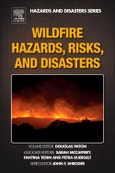More than 90% of wildfires are caused by human activity, but other causes include lighting, drought, wind and changing weather conditions, underground coal fires, and even volcanic activity. Wildfire Hazards, Risks, and Disasters, one of nine volumes in the Elsevier Hazards and Disasters series, provides a close and detailed examination of wildfires and measures for more thorough and accurate monitoring, prediction, preparedness, and prevention. It takes a geo-scientific and environmental approach to the topic while also discussing the impacts of human-induced causes such as deforestation, debris burning and arson-underscoring the multi-disciplinary nature of the topic. It presents several international case studies that discuss the historical, social, cultural and ecological aspects of wildfire risk management in countries with a long history of dealing with this hazard (e.g., USA, Australia) and in countries (e.g., Taiwan) where wildfire hazards represent a new and growing threat to the social and ecological landscape.
Table of Contents
1. Introduction to wildfire hazards, risks and disasters 2. United States case studies 3. Wildfire: A Canadian perspective 4. Current status of risk and prognosis of forest fires in Chile. Progress and future challenges 5. Wildfire situation in Europe 6. Wildfires: An Australian perspective 7. Fostering community preparedness to wildfire: Experiences from Indonesia 8. Forest fire in Taiwan 9. Wildfires in India: tool and hazard 10. System of wildfire monitoring in Russia 11. Wildland fire danger rating and early warning systems 12. Post fire ecosystem restoration 13. Weather, climate and wildland fire 14. Managing fire risk: Issues and emerging perspectives








